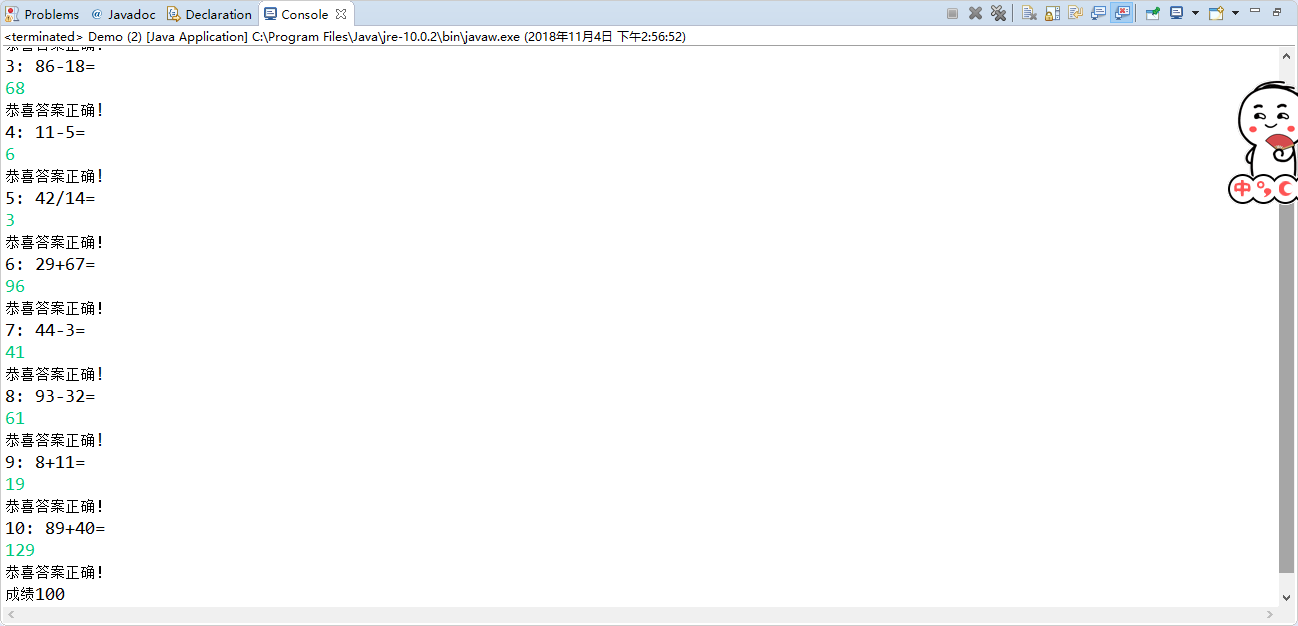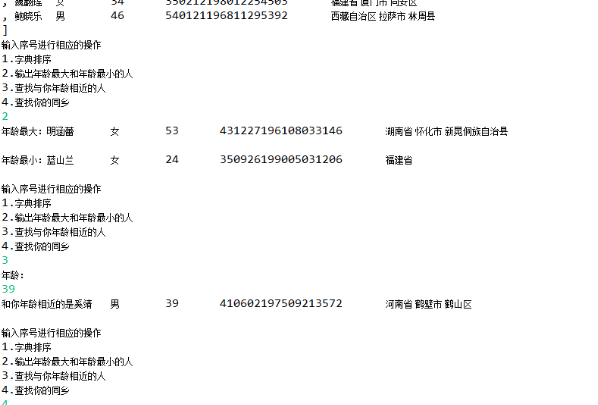一:理论部分。
1.数据结构:分为a.线性数据结构,如线性表、栈、队列、串、数组和文件。
b.非线性数据结构,如树和图。
1)所有数据元素在同一个线性表中必须是相同的数据类型。
线性表按其存储结构可分为顺序表和链表。
2)栈:也是一种特殊的线性表,是一种后进先出(LIFO)的结构。
栈是限定仅在表尾进行插入和删除运算的线性表,表尾称为栈顶,表头称为栈底。
3)队列:限定所有的插入只能在表的一端进行,而所有的删除都在表的另一端进行的线性表。是一种先进先出(FIFO)的结构。
表中允许插入的一端称为队尾,允许删除的一端称为队头。
2.集合:(容器)是一种包含多个元素并提供对所包含元素操作方法的类,其包含的元素可以由同一类型的对象组成,也可以由不同类型的对象组成。
1)集合框架:JAVA集合类库的统一架构。
2)集合类的作用(包含在java.util包中):提供一些基本数据结构的支持,如Vector、Hashtable、Stack等。
3)集合类的特点:a.只容纳对象;
b.集合类容纳的对象都是Object类的实例(一旦把一个对象置入集合类中,它的类信息将丢失)
4)Vector类:类似长度可变的数组。它只能存放对象,其元素通过下标进行访问。
5)Stack类(Vector的子类):它描述堆栈数据结构。(所有对象都有一个散列码,可以通过Object类的hashCode方法获得。)
3.集合框架中的基本接口:a.Collection(构造类集框架的基础):集合层次中的根接口,JDK未提供这个接口的直接实现类。
b.Set:不能包含重复的元素,即元素必须唯一。对象可能不是按存放的次序存放。(实 现 Set 接口的类有HashSet,TreeSet)
c.List:有序的集合,可以包含重复的元素。提供了按索引访问的方式。实现它的类有ArrayList和LinkedLis(如ArrayList:能够自动增长容量的数组)
d.Map:Map接口映射唯一关键字到值。包含了key-value对。Map不能包含重复的key。SortedMap是一个按照升序排列key的Map。
二:实验部分。
1、实验目的与要求
(1) 掌握Vetor、Stack、Hashtable三个类的用途及常用API;
(2) 了解java集合框架体系组成;
(3) 掌握ArrayList、LinkList两个类的用途及常用API。
(4) 了解HashSet类、TreeSet类的用途及常用API。
(5)了解HashMap、TreeMap两个类的用途及常用API;
(6) 结对编程(Pair programming)练习,体验程序开发中的两人合作。
2、实验内容和步骤
实验1: 导入第9章示例程序,测试程序并进行代码注释。
测试程序1:
l 使用JDK命令运行编辑、运行以下三个示例程序,结合运行结果理解程序;
l 掌握Vetor、Stack、Hashtable三个类的用途及常用API。
示例程序1:
import java.util.Vector;//实现自动增长的对象数组 class Cat { private int catNumber; Cat(int i) { catNumber = i; } void print() { System.out.println("Cat #" + catNumber); } } class Dog { private int dogNumber; Dog(int i) { dogNumber = i; } void print() { System.out.println("Dog #" + dogNumber); } } public class CatsAndDogs { public static void main(String[] args) { Vector cats = new Vector(); for (int i = 0; i < 7; i++) cats.addElement(new Cat(i)); cats.addElement(new Dog(7)); for (int i = 0; i < cats.size(); i++) ((Cat) cats.elementAt(i)).print();//进行强制类型转化 } }
程序运行结果如下:

由程序运行结果可知,程序在强制转换类型时出现异常,更改后程序如下:
import java.util.Vector;//实现自动增长的对象数组 class Cat { private int catNumber; Cat(int i) { catNumber = i; } void print() { System.out.println("Cat #" + catNumber); } } class Dog { private int dogNumber; Dog(int i) { dogNumber = i; } void print() { System.out.println("Dog #" + dogNumber); } } public class CatsAndDogs { public static void main(String[] args) { Vector cats = new Vector(); for (int i = 0; i < 7; i++) cats.addElement(new Cat(i)); cats.addElement(new Dog(7)); for (int i = 0; i < cats.size(); i++) if (cats.elementAt(i) instanceof Cat) //判断是否能进行强制类型转换 { ((Cat) cats.elementAt(i)).print();//能进行强制类型转换,输出为Cat型 } else { ((Dog) cats.elementAt(i)).print();//不能进行强制类型转化,输出为Dog型 } } }
程序运行结果如下:

示例程序2:
import java.util.*; public class Stacks //栈(先进后出) { static String[] months = { "1", "2", "3", "4" }; public static void main(String[] args) { Stack stk = new Stack(); for (int i = 0; i < months.length; i++) stk.push(months[i]);//进栈 System.out.println(stk); System.out.println("element 2=" + stk.elementAt(2)); while (!stk.empty()) System.out.println(stk.pop());//输出出栈元素 } }
程序运行结果如下:
示例程序3:
import java.util.*; class Counter { int i = 1;//不加权限修饰符:friendly型 public String toString() //把其他类型的数据转为字符串类型的数据 { return Integer.toString(i); } } public class Statistics { public static void main(String[] args) { Hashtable ht = new Hashtable(); for (int i = 0; i < 10000; i++) { Integer r = new Integer((int) (Math.random() * 20));//生成0到20(不包括20)的整型随机数 if (ht.containsKey(r))//判断r是否是哈希表中一个元素的键值 ((Counter) ht.get(r)).i++;//通过get方法获得其值 else ht.put(r, new Counter());//ht不存在 } System.out.println(ht); } }
程序运行结果如下:
测试程序2:
使用JDK命令编辑运行ArrayListDemo和LinkedListDemo两个程序,结合程序运行结果理解程序;
ArrayListDemo:
import java.util.*; public class ArrayListDemo//ArrayList使用了数组的实现 { public static void main(String[] argv) { ArrayList al = new ArrayList(); //在ArrayList中添加大量元素 al.add(new Integer(11)); al.add(new Integer(12)); al.add(new Integer(13)); al.add(new String("hello"));//下标从0开始,添加4个元素 // First print them out using a for loop. System.out.println("Retrieving by index:"); for (int i = 0; i < al.size(); i++) { System.out.println("Element " + i + " = " + al.get(i)); } } }
程序运行结果如下:
LinkedListDemo:
程序运行结果如下:
l 在Elipse环境下编辑运行调试教材360页程序9-1,结合程序运行结果理解程序;
l 掌握ArrayList、LinkList两个类的用途及常用API。
程序如下:
import java.util.*; /** * This program demonstrates operations on linked lists. * @version 1.11 2012-01-26 * @author Cay Horstmann */ public class LinkedListTest { public static void main(String[] args) { //创建a和b两个链表 List<String> a = new LinkedList<>();//泛型 a.add("Amy"); a.add("Carl"); a.add("Erica"); List<String> b = new LinkedList<>();//泛型 b.add("Bob"); b.add("Doug"); b.add("Frances"); b.add("Gloria"); //合并a和b中的词 ListIterator<String> aIter = a.listIterator(); Iterator<String> bIter = b.iterator(); while (bIter.hasNext()) { if (aIter.hasNext()) aIter.next(); aIter.add(bIter.next()); } System.out.println(a); //从第二个链表中每隔一个元素删除一个元素 bIter = b.iterator(); while (bIter.hasNext()) { bIter.next(); // skip one element if (bIter.hasNext()) { bIter.next(); // skip next element bIter.remove(); // remove that element } } System.out.println(b); // bulk operation: remove all words in b from a a.removeAll(b); System.out.println(a);//通过AbstractCollection类中的toString方法打印出链表a中的所有元素 } }
程序运行结果如下:

测试程序3:
l 运行SetDemo程序,结合运行结果理解程序;
程序如下:
import java.util.*; public class SetDemo { public static void main(String[] argv) { HashSet h = new HashSet(); //也可以 Set h=new HashSet() h.add("One"); h.add("Two"); h.add("One"); // 复制 h.add("Three"); Iterator it = h.iterator(); while (it.hasNext()) { System.out.println(it.next()); } } }
程序运行结果如下:

l 在Elipse环境下调试教材367页-368程序9-3、9-4,结合程序运行结果理解程序;了解TreeSet类的用途及常用API。
9—3:
import java.util.*; /** * An item with a description and a part number. */ public class Item implements Comparable<Item>//接口(泛型) { private String description; private int partNumber; /** * Constructs an item. * * @param aDescription * the item's description * @param aPartNumber * the item's part number */ public Item(String aDescription, int aPartNumber)//构造器 { description = aDescription; partNumber = aPartNumber; } /** * Gets the description of this item. * * @return the description */ public String getDescription() { return description; } public String toString() { return "[description=" + description + ", partNumber=" + partNumber + "]"; } public boolean equals(Object otherObject) { if (this == otherObject) return true; if (otherObject == null) return false; if (getClass() != otherObject.getClass()) return false; Item other = (Item) otherObject; return Objects.equals(description, other.description) && partNumber == other.partNumber; } public int hashCode() { return Objects.hash(description, partNumber); } public int compareTo(Item other)//排序 { int diff = Integer.compare(partNumber, other.partNumber); return diff != 0 ? diff : description.compareTo(other.description); } }
程序运行结果如下:

9—4:
import java.util.*; /** * This program sorts a set of item by comparing their descriptions. * @version 1.12 2015-06-21 * @author Cay Horstmann */ public class TreeSetTest { public static void main(String[] args) { SortedSet<Item> parts = new TreeSet<>(); parts.add(new Item("Toaster", 1234)); parts.add(new Item("Widget", 4562)); parts.add(new Item("Modem", 9912)); System.out.println(parts); NavigableSet<Item> sortByDescription = new TreeSet<>( Comparator.comparing(Item::getDescription));//把自定义类对象存入TreeSet进行排序 sortByDescription.addAll(parts); System.out.println(sortByDescription); } }
程序运行结果如图:

测试程序4:
l 使用JDK命令运行HashMapDemo程序,结合程序运行结果理解程序;
程序如下:
import java.util.*; public class HashMapDemo //基于哈希表的 Map接口的实现,提供所有可选的映射操作 { public static void main(String[] argv) { HashMap h = new HashMap(); // 哈希映射从公司名称到地址 h.put("Adobe", "Mountain View, CA"); h.put("IBM", "White Plains, NY"); h.put("Sun", "Mountain View, CA"); String queryString = "Adobe"; String resultString = (String)h.get(queryString); System.out.println("They are located in: " + resultString); } }
程序运行结果:

l 在Elipse环境下调试教材373页程序9-6,结合程序运行结果理解程序;
了解HashMap、TreeMap两个类的用途及常用API。
程序如下:
import java.util.*; /** * This program demonstrates the use of a map with key type String and value type Employee. * @version 1.12 2015-06-21 * @author Cay Horstmann */ public class MapTest//Map在有映射关系时,可以优先考虑 { public static void main(String[] args) { Map<String, Employee> staff = new HashMap<>(); staff.put("144-25-5464", new Employee("Amy Lee")); staff.put("567-24-2546", new Employee("Harry Hacker")); staff.put("157-62-7935", new Employee("Gary Cooper")); staff.put("456-62-5527", new Employee("Francesca Cruz")); // 打印所有条目 System.out.println(staff); // 删除一个条目 staff.remove("567-24-2546"); // 替换一个条目 staff.put("456-62-5527", new Employee("Francesca Miller")); // 查找一个值 System.out.println(staff.get("157-62-7935")); // 遍历所有条目 staff.forEach((k, v) -> System.out.println("key=" + k + ", value=" + v)); } }
程序运行结果如下:

实验2:结对编程练习:
l 关于结对编程:以下图片是一个结对编程场景:两位学习伙伴坐在一起,面对着同一台显示器,使用着同一键盘,同一个鼠标,他们一起思考问题,一起分析问题,一起编写程序。
l 关于结对编程的阐述可参见以下链接:
http://www.cnblogs.com/xinz/archive/2011/08/07/2130332.html
http://en.wikipedia.org/wiki/Pair_programming
l 对于结对编程中代码设计规范的要求参考:
http://www.cnblogs.com/xinz/archive/2011/11/20/2255971.html
以下实验,就让我们来体验一下结对编程的魅力。
l 确定本次实验结对编程合作伙伴:王海珍
l 各自运行合作伙伴实验九编程练习1,结合使用体验对所运行程序提出完善建议;
import java.io.BufferedReader; import java.io.File; import java.io.FileInputStream; import java.io.FileNotFoundException; import java.io.IOException; import java.io.InputStreamReader; import java.util.ArrayList; import java.util.Arrays; import java.util.Collections; import java.util.Scanner; public class Test{ private static ArrayList<Person> Personlist1; public static void main(String[] args) { Personlist1 = new ArrayList<>(); Scanner scanner = new Scanner(System.in); File file = new File("C:\Users\lenovo\Documents\身份证"); try { FileInputStream F = new FileInputStream(file); BufferedReader in = new BufferedReader(new InputStreamReader(F)); String temp = null; while ((temp = in.readLine()) != null) { Scanner linescanner = new Scanner(temp); linescanner.useDelimiter(" "); String name = linescanner.next(); String id = linescanner.next(); String sex = linescanner.next(); String age = linescanner.next(); String place =linescanner.nextLine(); Person Person = new Person(); Person.setname(name); Person.setid(id); Person.setsex(sex); int a = Integer.parseInt(age); Person.setage(a); Person.setbirthplace(place); Personlist1.add(Person); } } catch (FileNotFoundException e) { System.out.println("查找不到信息"); e.printStackTrace(); } catch (IOException e) { System.out.println("信息读取有误"); e.printStackTrace(); } boolean isTrue = true; while (isTrue) { System.out.println("1:按姓名字典序输出人员信息;"); System.out.println("2:查询最大年龄与最小年龄人员信息;"); System.out.println("3.输入你的年龄,查询身份证号.txt中年龄与你最近人的姓名、身份证号、年龄、性别和出生地"); System.out.println("4:按省份找你的同乡;"); System.out.println("5:退出"); int type = scanner.nextInt(); switch (type) { case 1: Collections.sort(Personlist1); System.out.println(Personlist1.toString()); break; case 2: int max=0,min=100;int j,k1 = 0,k2=0; for(int i=1;i<Personlist1.size();i++) { j=Personlist1.get(i).getage(); if(j>max) { max=j; k1=i; } if(j<min) { min=j; k2=i; } } System.out.println("年龄最大:"+Personlist1.get(k1)); System.out.println("年龄最小:"+Personlist1.get(k2)); break; case 3: System.out.println("place?"); String find = scanner.next(); String place=find.substring(0,3); String place2=find.substring(0,3); for (int i = 0; i <Personlist1.size(); i++) { if(Personlist1.get(i).getbirthplace().substring(1,4).equals(place)) { System.out.println("你的同乡:"+Personlist1.get(i)); } } break; case 4: System.out.println("年龄:"); int yourage = scanner.nextInt(); int close=ageclose(yourage); int d_value=yourage-Personlist1.get(close).getage(); System.out.println(""+Personlist1.get(close)); break; case 5: isTrue = false; System.out.println("再见!"); break; default: System.out.println("输入有误"); } } } public static int ageclose(int age) { int m=0; int max=53; int d_value=0; int k=0; for (int i = 0; i < Personlist1.size(); i++) { d_value=Personlist1.get(i).getage()-age; if(d_value<0) d_value=-d_value; if (d_value<max) { max=d_value; k=i; } } return k; } }
public class Person implements Comparable<Person> { private String name; private String id; private int age; private String sex; private String birthplace; public String getname() { return name; } public void setname(String name) { this.name = name; } public String getid() { return id; } public void setid(String id) { this.id= id; } public int getage() { return age; } public void setage(int age) { // int a = Integer.parseInt(age); this.age= age; } public String getsex() { return sex; } public void setsex(String sex) { this.sex= sex; } public String getbirthplace() { return birthplace; } public void setbirthplace(String birthplace) { this.birthplace= birthplace; } public int compareTo(Person o) { return this.name.compareTo(o.getname()); } public String toString() { return name+" "+sex+" "+age+" "+id+" "; } }
各自运行合作伙伴实验十编程练习2,结合使用体验对所运行程序提出完善建议;
package Demo; import java.io.FileNotFoundException; import java.io.PrintWriter; import java.util.Random; import java.util.Scanner; public class Demo { public static void main(String[] args) { Scanner in = new Scanner(System.in); Number counter = new Number(); PrintWriter out = null; try { out = new PrintWriter("test.txt"); } catch (FileNotFoundException e) { System.out.println("Error!"); e.printStackTrace(); } int sum = 0; for (int i = 1; i <= 10; i++) { int a = (int) Math.round(Math.random() * 100); int b = (int) Math.round(Math.random() * 100); int m; Random rand = new Random(); m = (int) rand.nextInt(4) + 1; switch (m) { case 1: a = b + (int) Math.round(Math.random() * 100); while(b == 0){ b = (int) Math.round(Math.random() * 100); } while(a % b != 0){ a = (int) Math.round(Math.random() * 100); } //a大于b,a%b为0(保证能整除) System.out.println(i + ": " + a + "/" + b + "="); int c0 = in.nextInt(); out.println(a + "/" + b + "=" + c0); if (c0 == counter.division(a, b)) { sum += 10; System.out.println("恭喜答案正确!"); } else { System.out.println("抱歉答案错误!"); } break; case 2: System.out.println(i + ": " + a + "*" + b + "="); int c = in.nextInt(); out.println(a + "*" + b + "=" + c); if (c == counter.multiplication(a, b)) { sum += 10; System.out.println("恭喜答案正确!"); } else { System.out.println("抱歉答案错误!"); } break; case 3: System.out.println(i + ": " + a + "+" + b + "="); int c1 = in.nextInt(); out.println(a + "+" + b + "=" + c1); if (c1 == counter.add(a, b)) { sum += 10; System.out.println("恭喜答案正确!"); } else { System.out.println("抱歉答案错误!"); } break; case 4: while (a < b) { b = (int) Math.round(Math.random() * 100); } //若a<b,则重新生成b(避免出现负数) System.out.println(i + ": " + a + "-" + b + "="); int c2 = in.nextInt(); out.println(a + "-" + b + "=" + c2); if (c2 == counter.reduce(a, b)) { sum += 10; System.out.println("恭喜答案正确!"); } else { System.out.println("抱歉答案错误!"); } break; } } System.out.println("成绩" + sum); out.println("成绩:" + sum); out.close(); } }
package Demo; public class Number<T> { private T a; private T b; public Number() { a = null; b = null; } public Number(T a, T b) { this.a = a; this.b = b; } public int add(int a,int b) { return a + b; } public int reduce(int a, int b) { return a - b; } public int multiplication(int a, int b) { return a * b; } public int division(int a, int b) { if (b != 0 && a%b==0) return a / b; else return 0; } }

在运行对方的程序时,大部分代码差不多,但在她的程序中有部分代码比我的要简洁,值得我在以后的实验中学习。
采用结对编程方式,与学习伙伴合作完成实验九编程练习1;
package xinxi; public class Student implements Comparable<Student> { private String name; private String number ; private String sex ; private int age; private String province; public String getName() { return name; } public void setName(String name) { this.name = name; } public String getnumber() { return number; } public void setnumber(String number) { this.number = number; } public String getsex() { return sex ; } public void setsex(String sex ) { this.sex =sex ; } public int getage() { return age; } public void setage(int age) { this.age= age; } public String getprovince() { return province; } public void setprovince(String province) { this.province=province ; } public int compareTo(Student o) { return this.name.compareTo(o.getName()); } public String toString() { return name+" "+sex+" "+age+" "+number+" "+province+" "; } }
package xinxi; import java.io.BufferedReader; import java.io.File; import java.io.FileInputStream; import java.io.FileNotFoundException; import java.io.IOException; import java.io.InputStreamReader; import java.util.ArrayList; import java.util.Arrays; import java.util.Collections; import java.util.Scanner; public class xinxi{ private static ArrayList<Student> studentlist; public static void main(String[] args) { studentlist = new ArrayList<>(); @SuppressWarnings("resource") Scanner scanner = new Scanner(System.in); File file = new File("F:\身份证号.txt"); try { FileInputStream fis = new FileInputStream(file); @SuppressWarnings("resource") BufferedReader in = new BufferedReader(new InputStreamReader(fis)); String temp = null; while ((temp = in.readLine()) != null) { @SuppressWarnings("resource") Scanner linescanner = new Scanner(temp); linescanner.useDelimiter(" "); String name = linescanner.next(); String number = linescanner.next(); String sex = linescanner.next(); String age = linescanner.next(); String province =linescanner.nextLine(); Student student = new Student(); student.setName(name); student.setnumber(number); student.setsex(sex); int a = Integer.parseInt(age); student.setage(a); student.setprovince(province); studentlist.add(student); } } catch (FileNotFoundException e) { System.out.println("学生信息文件找不到"); e.printStackTrace(); } catch (IOException e) { System.out.println("学生信息文件读取错误"); e.printStackTrace(); } boolean isTrue = true; while (isTrue) { System.out.println("输入序号进行相应的操作"); System.out.println("1.字典排序"); System.out.println("2.输出年龄最大和年龄最小的人"); System.out.println("3.查找与你年龄相近的人"); System.out.println("4.查找你的同乡"); String n = scanner.next(); switch (n) { case "1": Collections.sort(studentlist); System.out.println(studentlist.toString()); break; case "2": int max=0,min=100; int j,k1 = 0,k2=0; for(int i=1;i<studentlist.size();i++) { j=studentlist.get(i).getage(); if(j>max) { max=j; k1=i; } if(j<min) { min=j; k2=i; } } System.out.println("年龄最大:"+studentlist.get(k1)); System.out.println("年龄最小:"+studentlist.get(k2)); break; case "3": System.out.println("年龄:"); int yourage = scanner.nextInt(); int near=agenear(yourage); @SuppressWarnings("unused") int value=yourage-studentlist.get(near).getage(); System.out.println("和你年龄相近的是"+studentlist.get(near)); break; case "4": System.out.println("输入你的家乡"); String find = scanner.next(); String place=find.substring(0,3); for (int i = 0; i <studentlist.size(); i++) { if(studentlist.get(i).getprovince().substring(1,4).equals(place)) System.out.println("你的同乡是 "+studentlist.get(i)); } break; } } } public static int agenear(int age) { @SuppressWarnings("unused") int j=0,min=53,value=0,k=0; for (int i = 0; i < studentlist.size(); i++) { value=studentlist.get(i).getage()-age; if(value<0) value=-value; if (value<min) { min=value; k=i; } } return k; } }

l 采用结对编程方式,与学习伙伴合作完成实验十编程练习2。
package jisuan; import java.io.*; import java.io.PrintWriter; import java.util.Scanner; public class Jisuan { public static void main(String[] args) { Scanner in = new Scanner(System.in); PrintWriter output = null; try { output = new PrintWriter("text.txt"); } catch (FileNotFoundException e) { // TODO Auto-generated catch block e.printStackTrace(); } int sum = 0; for (int i = 1; i <= 10; i++) { int a = (int) Math.round(Math.random() * 100); int b = (int) Math.round(Math.random() * 100); int m = (int) Math.round(Math.random() * 4); switch (m) { case 1: while (b == 0) { b = (int) Math.round(Math.random() * 100); } while (a % b != 0) { a = (int) Math.round(Math.random() * 100); } System.out.println(a + "/" + b + "="); int c1 = in.nextInt(); output.println(a + "/" + b + "=" + c1); if (c1 == a / b) { System.out.println("恭喜答案正确"); sum += 10; } else { System.out.println("抱歉,答案错误"); } break; case 2: System.out.println( a + "*" + b + "="); int c2 = in.nextInt(); output.println(a + "*" + b + "=" + c2); if (c2 == a * b) { System.out.println("恭喜答案正确"); sum += 10; } else { System.out.println("抱歉,答案错误"); } break; case 3: System.out.println( a + "+" + b + "="); int c3 = in.nextInt(); output.println(a + "+" + b + "=" + c3); if (c3 == a + b) { System.out.println("恭喜答案正确"); sum += 10; } else { System.out.println("抱歉,答案错误"); } break; case 4: while (a < b) { a = (int) Math.round(Math.random() * 100); } System.out.println( a + "-" + b + "="); int c4 = in.nextInt(); output.println(a + "-" + b + "=" + c4); if (c4 == a - b) { System.out.println("恭喜答案正确"); sum += 10; } else { System.out.println("抱歉,答案错误"); } break; } } System.out.println("成绩" + sum); output.println("成绩" + sum); output.close(); } }
package jisuan; public class math<T> { private T a; private T b; public int add(int a, int b) { return a + b; } public int reduce(int a, int b) { return a - b; } public int multiplication(int a, int b) { return a * b; } public int division(int a, int b) { if (b != 0 && a % b == 0) return a / b; else return 0; } }

实验总结:
通过本周学习,我进一步复习了一些有关数据结构的知识,另外初步了解了java集合类,也了解了Vector类,Stack类以及Hashtable类。除此以外,此次实验第一次采用结对编程的方法,通过和合作伙伴互相运行程序,相互讨论交流,从中学到了很多东西。希望以后多采取这种方法,在合作中互相学习进步。